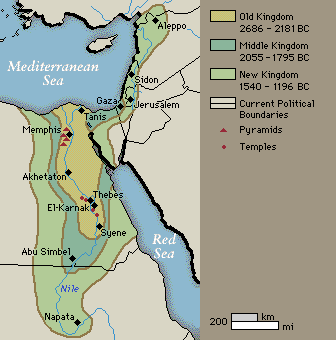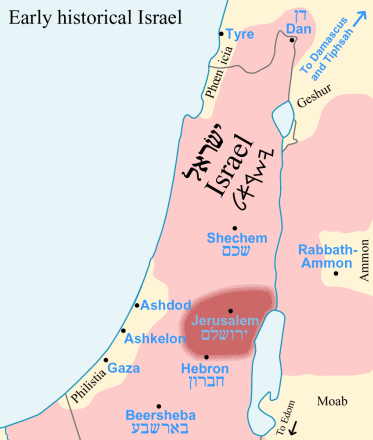Jewry: Fake and truth in the Old Testament (OT) according to documents and excavations
New identity by new Jewish history by help of chronology and archaeological research
4. Archaeological findings about Israeli tribes after the faked occupation: the occupation was a fluent one
Map: Egyptian Empires
by Michael Palomino (2006 / 2010)
| Share: |
Facebook |
|
Twitter
|
|
|
|
from: Israel Finkelstein / Neil A. Silberman: The Bible unearthed. Archeology's New Vision of Ancient Israel and the Origin of Its Sacred Texts; The Free Press, a division of Simon & Schuster, Inc., 2001; German edition has got the title "No trombones before Jericho" (orig. German: "Keine Posaunen vor Jericho"): edition C.H.Beck oHG, Munich 2002;
Here in this analysis is used the German version "Keine Posaunen vor Jericho" of DTV, Munich 2004, second edition of 2005. All page indications refer to the German version. I hope the page numbers are not very different.
Archaeological facts: The differences between Canaanites and Israelites
Canaanites towns e.g. on the coast
Israeli villages bordering the desert
-- are towns full of arts
-- are towns full of ceramics
-- are towns with great buildings
-. are towns with imported luxury
-- are towns with fine worked ceramic vessels (p.116)
-- are villages with shafts without plans
-- are villages where only rough ceramics can be found as with half nomads (p.116)
-- are villages with only rough tools and instruments (p.116-117)
Finkelstein / Silberman: Posaunen 2001, edition 2004
The development of the city towns coming from the oval villages
Excavations in old villages in the today Israel Palestine are giving the result that in the population there was developed an ethnic Israeli identity only step by step (p.113).
The villages of today partly have essential differences:
Jerusalem / Urusalim
According to archaeological findings Jerusalem - which was called Urusalim in these times - never had any big monument or fortress, and according to historian Nadav Naaman this Jerusalem was the center of only a very small elite (p.259).
around 1,200 B.C.
Beginnings of an Israelite identity in 250 mountain villages (European Iron Age I)
-- archeology can state 250 new communities on mountain tops, and this was really a wave of foundations, in the South from the Jewish highlands up to the highlands of Samaria in the North
-- around 1,200 B.C. there had been a dramatic change as it seems, with a basic change of kind of living
-- there was no violent invasion or infiltration of another ethnic group, there are no findings for this [of fires, ashes or other findings of violence]
-- the villages on the mountain tops are populated until the times of kings
-- according to Finkelstein / Silberman the highland population of the highland villages can be considered as the first Israelite population (p.123).
Simple life in the mountain villages during European Iron Age I
The layout of the village
-- the villages contained approximately 100 inhabitants each on appr. 1/2 hectare, maximum were some 100 inhabitants on 1.5 hectares (p.124)
-- the villages mostly were on mountain tops or on a little ridge (p.123), and the territory mostly was not bigger than 1/2 hectare (p.123-124), mostly on the eastern margin of the fields, with a great view (p.123)
-- the forests consisted mainly of oaks and terebinths
-- sometimes but very seldom the village was founded also at the ridge of narrow valleys
-- water was collected for "winter" in water cisterns in the rock with rainwater, or there was brought water from a spring (p.123).
[Climate fluctuations with colder winters or summers are not mentioned by Finkelstein / Silberman].
The oval layout of the mountain top villages
First are constructed the villages on border to the desert where both kinds of living with herds and agriculture are possible. Only later the villages are constructed more in the West where it's less favorable for herds and for agriculture, but it's more favorable for olive cultures and for vineyards (p.120).
Political position of the mountain villages
-- the position of the villages is absolutely offside of the big trade routes, there is no foreign trade, and good craftsman do not exist either (p.126)
-- the villages have no walls, perhaps because it was not necessary, or because there were no means and no wisdom for it (p.125)
-- there is no indication of any attack by fire or destruction by violence (p.126)
-- the villages have no public buildings, have no documents, have no seals, and have no imported ceramics, and have hardly jewelry
-- all houses have more or less the same size, one house has a surface of appr. 56 m2, and by this it can be admitted that also the possessions were distributed more or less in the same quantities
-- all houses are made of rough field stones, rough stone columns are roof supports or are columns for the second floor (p.124)
-- between the the houses there are stony pits which serve as corn deposit (p.124).
Equipment
-- in every house there are many grindstones and many sickle blades for corn economy
-- courtyards with fences are indications for keeping of animals where the animals were kept in the night
-- jugs and pots were of ceramics
-- there could be found findings from tombs, but hardly findings from cults, only in one single village in the northern highlands was found a figurine of a bull of bronze, an indication of a Canaanite cult (p.124)
-- [and there were found no skeletons?]
-- on Ebal Mountain there is a strange stony structure interpreted as an old Israeli altar, but the function of this installation around this stony structure is controversial (p.125)
-- nowhere could be found any weapon (p.126).
Economy
There was agriculture and pasture agriculture with plow of oxes and with sheep and goat herds (p.126).
Village development
-- the houses and farms are amplified during the decades and centuries
-- only in rare cases the original building has been preserved. It was mostly torn down and there was constructed a second building on the first one
-- in the village Izbet-Sartah there was preserved the old oval village center, and the new houses were constructed around the center (p.127).
Philistine ceramics coming up since 1,200 B.C. appr.
Archeology states that there is an ornamentation wave coming from the Aegean, so a new "Philistine ceramic" is formed. This wave of stylistic cultural influence of Philistine ceramic is reaching the foothills - according to the archaeological findings. This ceramic can always be stated in a certain layer, from the North down to Jezreel plain (p.151).
Map with the territories of the Israelites according to the old and wrong historiography "from Dan to Beersheba";
in dark red kingdom of Judah is painted.
Add to this neighbor states Phoenicia, Geshur, Philistine, Ammon and Moab are indicated.
Map with the different Egypt Empires
around 1000 B.C.
Climax of the mountain villages with almost 45,000 inhabitants
according to archaeological field research (p.124).
Ethnic differentiation between the Israelites and others: no pork
Ethnicities are manifesting themselves by language, religion, clothing, rites of burial, and nutrition rules (p.135). Israelite villages up to the kingdoms have got the characteristic that the archaeologists cannot find any bone of a pig. The population resigns to pork, as it seams, and by this they make a difference to the neighbor populations of Ammon, Moab, and Edom (p.136).
With the earlier waves of villages there were always bones of pigs to be found, but with the last wave of villages not any more (p.136).
To the contrary in the villages of the Philistines a considerable part of the bones is from pigs (p.136).
Finkelstein / Silberman admit that the prohibition of pork was an element of a common identity of "proto Israelites". By this the village populations created a new ethnic barrier. The reasons for the prohibition of pork and the ethnic barrier are not cleared. The custom resigning to pork is the oldest proven cultural custom (p.136).
[Addition:
In certain regions the pig was a holy animal. There was some reason to deny the pig, also making difference to other believes].
The legend of Isaak and the eternal quarrel of the twins Jacob and Esau about the right of primogeniture
OT claims:
-- Isaak is said having met "Abimelech, the king of the Philistines" in the town of Gerar (Genesis 26,1) (p.50)
-- the woman of Isaak, Rebeka, is said having been pregnant with twins and having received a prophecy that these twins would be the origin for two separate folks, "and the elder will serve the younger" (Genesis 25,23) (p.52-53)
-- the wife of Isaak, Rebeka, is said having born the twins Esau and Jacob, and their descendants are said having fought each other for centuries because Rebeka is said having sent her favorite son Jacob disguised to the deathbed of father Isaak, and by this method he is said having received the right of primogeniture whereas this right of primogeniture principally had been for Esau (p.43)
-- by this Esau allegedly has to found his tribe in the desert, and by this the Israelite tribes Esau and Jacob are said having made war for 100s of years because of this right of primogeniture: Jacob is said having taken the flight of the anger of Esau, but God is said having confirmed the right of primogeniture for Jacob (Gen. 18, 13-15) (p.53)
-- by this Jacob should rule as an educated patriarch over Esau who is only a hunter like patriarch of Edom (p.53).
The contradictions in the legend of Isaak: the criterion of the city of Gerar: Gerar only was a village in the times of Isaak
The town of Gerar and Isaak visiting the Philistine king Abimelech (Gen. 26,1) are not fitting together because the Philistines were constructing their towns in the coastal plane of Canaan coming from Aegean, but only after 1200 B.C. during the growth in 11th and 10th century B.C. They ruled Canaan until far in the Assyrian period (p.50).
Today the town of Gerar (today identified as Tel Haror north west of Beersheba) is mentioned in the text of Abraham (Gen. 20,1) and seems having been especially important in the moment of the writing down of Pentateuch (7th century B.C.), at least it was very known. But at the beginning of European Iron Age, in the period when Isaak is said having lived, Gerar is only an insignificant village at the beginning of Philistine history - according to excavations.
Then, in 8th and 7th century B.C., Gerar is growing much and is an important fortified Assyrian administrative center, "an obvious landmark". (p.50)
Conclusion
The town of Gerar which was only a little village in the times of Isaak, is an evidence that Isaak has not existed. But conservative scholars are writing these circumstances about the town of Gerar off as a secondary detail and believe until today that there existed the two twins Jacob and Esau always in wars (p.50).
|
|
|
Photo sources
-- map of Israel and neighbor states around 1100 B.C.: http://symbolictruth.fateback.com/biblisrl.htm
-- map of Egypt kingdoms: http://uk.encarta.msn.com/medias_761557408/Egypt.html
^



